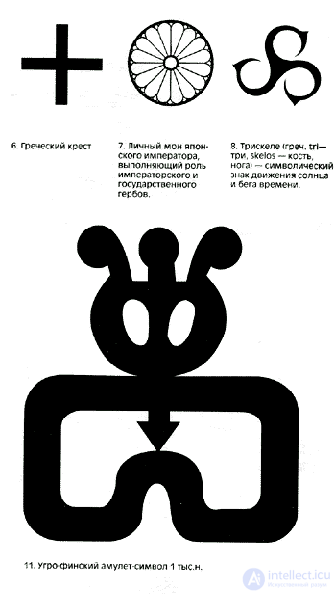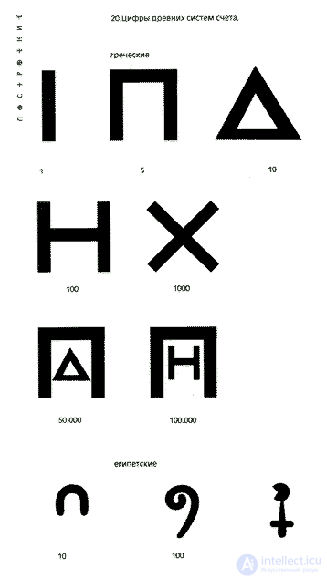The concept of a trademark.
Functional features of trademarks source: ABC advertising The history of symbolic symbolism is directly related to the development of civilization, the emergence of a written pictorial language, its genesis in time and space.
Therefore, it is rather difficult with a certain degree of probability, operating with scattered bits of facts a thousand years ago, to give an unconditional definition of a particular symbol. In addition, the same images can be observed in different nations in different parts of the world. This applies, first of all, to simple geometric shapes - a triangle, a circle, a square, a cross, a star. The current archaeologists and historians have to more theoretically restore the situation of a particular time, guided by the logic of common sense and intuition, given the social psychology of human behavior, which has not changed much over the past ten thousand years.
The reason is that over time, almost all materials used for the construction of housing, the manufacture of clothing, jewelry, weapons and household utensils are destroyed, becoming sand, rust, dust and ashes. Products made of precious metals, buried along with the departed, unfortunately, throughout all ages have been the object of rapt attention of treasure hunters and mostly plundered.
The development of the written language and abstract symbolism can be judged by the ceramics and stone monuments of hieroglyphic writing (Sumerian 4 thousand BC, Egyptian end 4 thousand BC, proto-Indian 3 thousand BC, Chinese 2 thousand BC. e.), having already formed form. The origin of the letter occurred earlier (the Neolithic, Eneolithic, 7-12 thousand BC), but the written records of that time almost did not survive.
The Bronze Age (in Front Asia - from the end of 4 thousand BC; in Europe - from the beginning of 2 thousand BC) was a period of rethinking, unifying and widespread cult Neolithic symbolism. The characters became more stable in shape. Most of the examples of the symbolism of antiquity that has come down to us date back to that time. Then, in the era of iron (the first half of 1 thousand BC), there was a departure from the use of symbols; Apparently, even then their semantic content was forgotten. They were used for a long time, but already as ornaments or as sacred signs fixed by custom.
The ancient symbolism, and especially its later ornamental interpretation, is an overlay of motifs belonging to different eras, and a wreath of plots of various ethnocultural origin.
Similar cult symbols and ornamental motifs are widespread; quite often similar or even identical elements are found among clearly unrelated peoples. But although identical symbols were used in different places and in different epochs, the specific nature of their styles is peculiar to certain cultures, besides, there are symbols that have a specific owner. Personality and the abstract sign personified with it, be it the sign of the Emperor of China in China or a tamga of the kind of the steppe Khan of the owner of the horse herd, the sign of the master - blacksmith and potter, all this is close to the concept of a modern trademark.

With the development of trade, the emergence of cities in the Mediterranean in the 4-5th century BC. markets began to form. The use of distinctive signs in pastoralists, farmers, artisans, slave traders becomes the imperative of time. Identification marks are becoming more usable, and, apparently, from this position they can also be called commodity. Well preserved signs of stone cutters, found on the walls of Pompeii, in the architecture of Palestine. The master usually wrote his name and concluded it in the simple form of a circle, square, rhombus and rectangle. Literacy and literacy spread in medieval society. Among the urban population there are signs printed on trade documents, on sea and river vessels, carts, tools, goods and household goods of the owner of the mark. Thus, in the XII century, the scope of the trademark and the prestige of its owner expanded significantly.

The use of the manufacturer's mark in the second half of the XIV century already provides for responsibility for the quantity and quality of the material used, for the technical level and other properties inherent in a particular product. Be it a clock, a carriage, a brick or a ship's cannon. In 1363, the English king Edward III obliged all enterprises making metal products to have their own distinctive mark. From the middle of the 15th century, when book printing appeared in Europe, a book dated 1457 was marked, with a publisher's sign and imprint. Further, the signs of the publisher began to be used everywhere. In Russia, the branding of goods becomes mandatory in the time of Peter I. Together with the development of the economic system of many countries, a trademark has become an indispensable attribute of any product or service intended for a specific consumer. Undoubted interest in the trademark, as a small graphic form connecting the seller, the manufacturer and the buyer, due to the new economic conditions of existence of our country. First of all, it is the refusal of the state from a monopoly on many types of products and services. The emergence of many enterprises, aimed primarily at making a profit, as an indispensable condition for life. And the natural clash of interests in the activities of producers of the same product or service.
Trademark concept The nascent competitive struggle for the buyer's wallet should begin with the designation of the contending parties involved in the sale process. For this, a trademark is best suited as a means of identifying its goods or services used by enterprises and organizations everywhere. Any graphic image of a word, symbol, concept or event can in principle be considered the basis of a trademark. The main forms of its existence can be considered in the following sections of the book. But whatever the form of trademarks may be, their main function is to distinguish a particular product or service of one enterprise from the products of its competitors. Trademarks have much in common with proper names: the thoroughness with which they are chosen and presented; "paternal" custody of an enterprise acting as an ederer; their spelling (with a capital letter); their magical ability to cause associations; their almost sanctified origin; their registration; their exclusivity and legal protection.

Ever since man began to use words, they have served to evoke in the minds of people the image of those objects which they symbolized. Since time immemorial, the name has always been the second "I" of a person. To know the name of a person meant to have power over his soul. Mere mortals did not dare to know the names of their rulers. Powerful ancient deities had many names, each of which expressed some aspect of their power. The depth of the impact of this language of characters sometimes borders on magic. And undoubtedly the magical or semi-magical influence of trademarks, both on the buyers and on the sellers themselves, who have given the second name to the product, service or enterprise, which they personify.
Historical monograms: 1 - Byzantium, Narses. 2 - Greece, Jesus Christ the Victor. 3 - Byzantium, Justinian. 4 - Charlemagne. 5 - Albrecht Dürer. 6 - Friedrich I. Barbarossa. 7 - Christian monogram. 
Due to the enormous increase in the mass of products entering the market, the influx of new trademarks forms a real flood, and since most of them consist of words, the languages of all nations are continuously replenished with new words that serve as trademarks. Industrialists and consumers alike use them as ordinary words in the same grammatical meaning as words existing in the language, with which signs are closely related as proper names, nouns or adjectives, and in some cases even interjections or exclamations. Thus, trademarks gradually occupy a position that, as practice shows, most fully corresponds to their specificity.
 Functional features of trademarks It is usually considered that trademarks should perform the following functions:
Functional features of trademarks It is usually considered that trademarks should perform the following functions: a) Facilitate perception of differences or create differences. The differences that exist between trademarks are designed to make consumers realize that this particular product is different from others similar to it. Signs perform this function in parallel with other means of product identification — packaging, shape, color, weight, etc. Without the help of trademarks or labels, it is extremely difficult or even impossible for consumers to recognize the most common products.
b) give the goods names. Consumers identify products by the pronunciation of words or by the verbal designation of images chosen as trademarks. Because it is much easier to force a customer to pronounce a printed word mark than to put an image into words. Approximately 80% of all trademarks are verbal.
"The highly profitable service provided by trademarks is the broadcast advertising of organizations and enterprises aimed at raising their reputation in the eyes of the public, and ultimately, therefore, at increasing their sales. The trademark is called a" silent seller "," showcase, "but in reality its loud voice sounds everywhere in our trading activity" (P. Brock).
c) Facilitate the identification of the goods. The recognition of a trademark is greatly facilitated by the relatively wide popularity of the images depicted. That is why they often display well-known symbols - the sun, stars, people, animals, plants, written signs and numbers.
d) Facilitate the memorization of the goods. And in this case, the degree of familiarity with the subject, awareness of its properties, displayed on a trademark, which may be the result of an advertising campaign, plays a very important role. A consumer who has not seen this mark needs more mental effort to identify him with a particular product when he is in front of his eyes. The expenditure of such efforts presupposes the ability to recapture the seen images. Simple trademarks are naturally easier to remember.
However, such simplicity is relative. When an object shown on it is known to a consumer, an image, even a very complex one, is easier to remember than a simpler image of an unfamiliar object.

d) Indicate the origin of the goods. Trademarks do not necessarily indicate the origin of the product. However, chosen as such, the symbol is always rooted in some particular cultural environment, and therefore it often shows that the product represented by the sign comes from the same cultural environment. An example of this is the trademarks of American, Japanese or Russian cars. But they often choose such trademarks that are associated not so much with the culture of the country of origin of the goods, as with the cultural patterns of the consumer countries.
e) Report product information. When an entrepreneur wishes to demonstrate in the trademark the individual properties of his product, he has to find figurative elements reflecting just the indicated properties. The problem is to find such a word or to create such an image, which generates the desired idea about the product.
g) Stimulate the desire to buy. Various factors that are closely related to the image created by the trademark, such as factors of technical properties, factors relating to the gender of the buyer or his snobbish nature, can have a stimulating effect on making a purchase.
The inherent function of a trademark is limited by its ability to instill in the buyer the confidence that the product concept it creates is true.
h) Symbolize quality assurance. In the eyes of the consumer, trademarks can be a symbol of the guarantee that prices and quality of goods with the same sign will not differ from each other. It is assumed that the car model "Lada" has the same qualities as any other car that carries the same mark.








Comments
To leave a comment
design software UI and Web design
Terms: design software UI and Web design